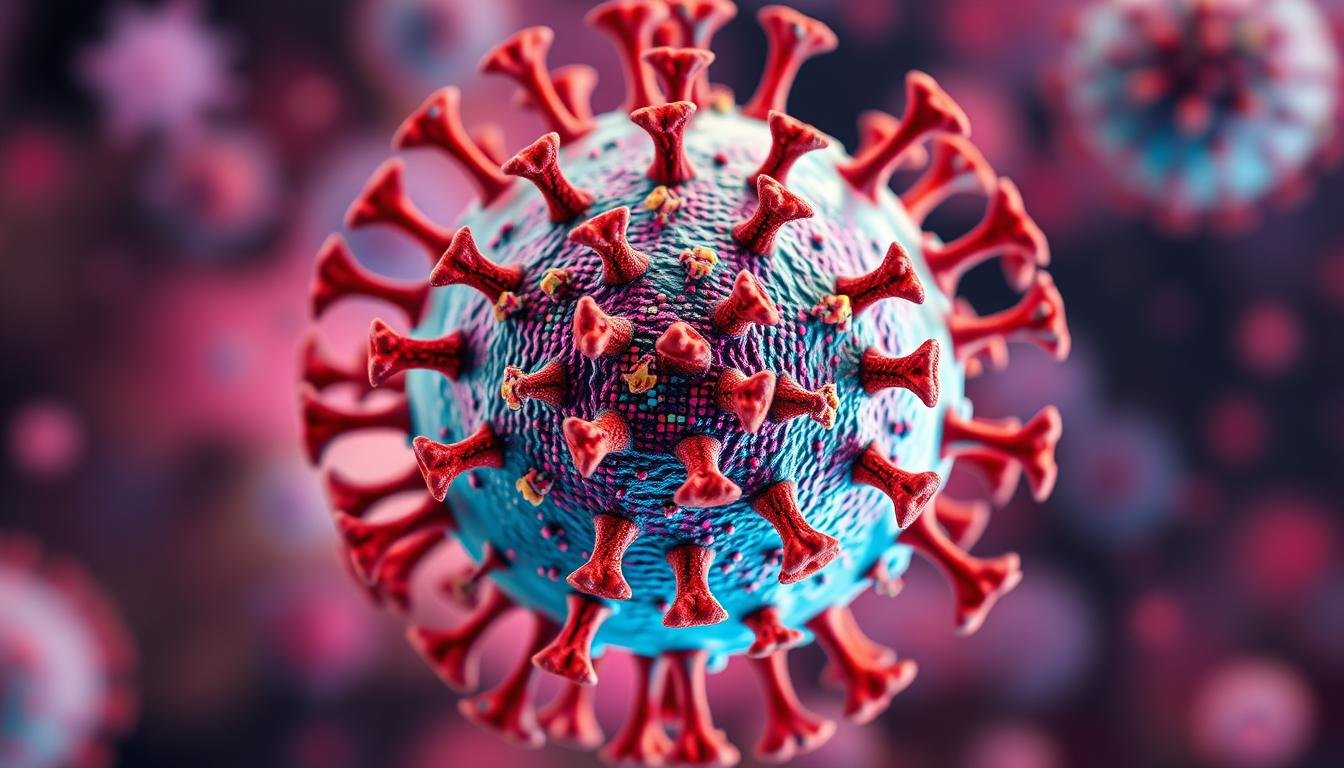The hMPV respiratory virus, also known as human metapneumovirus, is a major cause of respiratory illness. It affects people of all ages, but mostly young children, older adults, and those with weak immune systems. Since it was discovered in 2001, it has been linked to many respiratory problems. Symptoms can range from mild to severe, including cough, fever, and shortness of breath.
The virus can lead to serious symptoms, needing medical help, in vulnerable groups like infants and the elderly. Since there’s no specific treatment for hmpv, doctors focus on easing symptoms. Symptoms usually last from 1 week to 10 days. Knowing about hMPV is key to treating and preventing it.
Key Takeaways
- The hMPV respiratory virus is a significant cause of upper and lower respiratory disease in people of all ages.
- Young children, older adults, and individuals with weakened immune systems are at the highest risk for severe symptoms and complications.
- No specific antiviral treatment exists for hmpv; management focuses on symptom relief.
- Preventive measures include frequent hand washing and avoiding close contact with infected individuals.
- hmpv cases account for a notable percentage of weekly respiratory virus cases, particularly among infants and children.
- Severe symptoms may escalate to respiratory distress or pneumonia, especially among those with pre-existing health conditions.
Understanding hMPV Respiratory Virus
Human Metapneumovirus (hMPV) is a virus from the Pneumoviridae family, like the respiratory syncytial virus (RSV). It was first found in 2001. It causes upper and lower respiratory infections in people of all ages. Knowing hMPV symptoms helps in early diagnosis and treatment.
hMPV has been around for decades. It’s important in respiratory health, causing severe illness in young children and older adults. hMPV prevention, like handwashing and avoiding sick people, can help stop its spread.
Some key facts about hMPV include:
- It is a common cause of upper respiratory infections in infants and children under 5 years old.
- Populations at high risk for severe illness include infants, older adults, and individuals with health conditions such as immunosuppression, COPD, and asthma.
- There is currently no vaccine licensed for hMPV, but research is ongoing to develop one.
Understanding hmpv symptoms helps prevent its spread. Taking steps to prevent it and seeking medical help when needed is crucial. Effective treatment for hmpv and hmpv prevention measures can lessen its impact on respiratory health.
| Age Group | Risk of Severe Illness |
|---|---|
| Infants | High |
| Older Adults | High |
| Individuals with health conditions | High |
Common Symptoms of hMPV Infection
Human metapneumovirus (hMPV) is a common cause of respiratory infection in people of all ages. It mainly affects young children and older adults. Symptoms can range from mild to severe and may look like other respiratory viruses.
Recent data shows that hMPV symptoms include cough, fever, nasal congestion, and shortness of breath.
Some key facts about hMPV infection are:
- Most people are infected with hMPV at least once before the age of 5.
- hMPV accounts for about 10% of all respiratory infections in children.
- Around 5% to 10% of hMPV infections result in hospitalizations among children.
The hMPV infection can be severe, mainly in young children and older adults. Recognizing symptoms early is crucial. This can prevent complications and improve outcomes.
The incubation period for hMPV is between 3 to 6 days. Symptoms usually last about 2 to 7 days.
There are no antiviral therapies or vaccines for hMPV. But, infection prevention strategies are key to reducing its spread. By understanding symptoms and taking preventive measures, we can protect ourselves and our loved ones from this respiratory infection.
How hMPV Spreads in Communities
Human metapneumovirus (hMPV) is a contagious respiratory virus. It spreads fast in communities. hMPV research shows it mainly spreads through coughing and sneezing, touching, and touching surfaces with the virus then touching your face.
The ways hMPV transmission happens are like other respiratory viruses. It’s most active in winter and spring. Places like hospitals, schools, and daycare centers are high-risk because people are close together.
To stop hMPV, good respiratory virus prevention is key. Wash hands often, cover your mouth when coughing, and stay away from the sick. These steps help you avoid getting hMPV and stop it from spreading.
Some important facts about hMPV transmission are:
- hMPV spreads through droplets, contact with surfaces, and close contact.
- The virus can live on surfaces for hours, so clean and disinfect often.
- People with weak immune systems, like the elderly and young kids, get very sick.
Risk Factors and Vulnerable Populations
Human metapneumovirus (hMPV) can cause infections in people of all ages. But, it often leads to respiratory illnesses in young children and older adults. Early diagnosis and monitoring are key for these high-risk groups. Practices like hand hygiene and good respiratory etiquette can help prevent the spread of hMPV.
Studies show that hMPV infection rates vary from 2.2% to 10.5% in adults during winter. Identifying hMPV is vital for proper treatment. Yet, there’s no specific treatment or vaccine for hMPV. Treatment mainly aims to ease symptoms and boost the immune system.
- Age: Young children and older adults are more susceptible to hMPV infection.
- Chronic respiratory conditions: Individuals with conditions such as asthma or COPD are at higher risk of developing severe hMPV infections.
- Weakened immune system: People with compromised immune systems, such as those with HIV/AIDS or undergoing chemotherapy, are more vulnerable to hMPV infection.
| Population | Risk Factor | Prevention Strategy |
|---|---|---|
| Young children | Age | Hand hygiene practices, respiratory etiquette |
| Older adults | Age, chronic respiratory conditions | Flu vaccination, pneumonia vaccination |
| Individuals with weakened immune systems | Weakened immune system | Avoid close contact with individuals who are sick, practice good hygiene |
Diagnosing hMPV Respiratory Virus
It’s hard to diagnose hMPV because it looks like other viruses. But, laboratory testing methods like NAAT and immunofluorescence can spot hMPV infection.
A clinical assessment is key too. It helps figure out the illness’s symptoms and how bad it is. Knowing it’s hMPV is important for the right hmpv treatment.
When diagnosing hMPV, we look at the patient’s past health, physical check-ups, and lab results. We also need to rule out other viruses and bacteria that might cause similar symptoms.
Some ways to diagnose hMPV include:
- Nucleic acid amplification test (NAAT)
- Immunofluorescence
- Enzyme immunoassay
Quick diagnosis and treatment of hMPV are vital. They help avoid serious problems and manage the illness well. If symptoms don’t get better or get worse, seek medical help. This is true for high-risk groups like babies, older people, and those with weak immune systems.
| Method | Description |
|---|---|
| Nucleic acid amplification test (NAAT) | Detects the presence of HMPV genetic material in respiratory secretions |
| Immunofluorescence | Detects the presence of HMPV antigens in respiratory secretions |
| Enzyme immunoassay | Detects the presence of HMPV antibodies in the blood |
Treatment Approaches and Management
There is no specific treatment for hMPV yet. No vaccine exists to prevent it. Medical care focuses on easing symptoms and avoiding serious issues. Respiratory virus prevention is key, like washing hands and covering your mouth when coughing.
Recent studies suggest ribavirin might help fight hMPV in lab tests. But more research is needed to see if it works in people. For now, treatment mainly aims to manage symptoms and prevent serious problems.
Important aspects of hMPV treatment include:
- Supportive care, such as oxygen therapy and hydration
- Monitoring for complications, such as pneumonia or bronchiolitis
- Preventive measures, such as hand hygiene and respiratory etiquette

Healthcare professionals can offer effective hMPV treatment and management. This reduces the risk of serious issues and improves patient care.
| Age Group | hMPV Infection Rate |
|---|---|
| Children (1-12 years) | 10% |
| Adults | 3.5% |
Complications Associated with hMPV
hMPV infection can cause serious problems, mainly in the elderly, young kids, and those with breathing issues. Respiratory illness from hMPV can be mild or severe, sometimes needing hospital care.
Common issues include pneumonia, bronchiolitis, and worsening of conditions like asthma. Reports show severe cases with symptoms like wheezing, breathing trouble, and cough. These hMPV symptoms need quick medical help.
hMPV is behind 7 to 19% of respiratory infections in kids, both in hospitals and clinics. It leads to 1 in 1,000 kids needing hospital care each year. This is similar to flu but less than hRSV.
| Complication | Description |
|---|---|
| Pneumonia | A severe respiratory illness that can require hospitalization. |
| Bronchiolitis | An inflammation of the small airways in the lungs is common in young children |
| Asthma exacerbation | HMPV infection can trigger asthma symptoms in individuals with pre-existing asthma. |
Knowing the hMPV symptoms and getting medical help when needed is key. It helps avoid serious issues and aids in quick recovery from respiratory illness caused by hMPV.
Prevention Strategies and Best Practices
To stop HMPV and other respiratory viruses from spreading, hmpv prevention strategies are key. This means washing hands often with soap and water for at least 20 seconds. It also means avoiding touching your eyes, nose, or mouth with unwashed hands. And, it’s important to stay away from people who are sick. Keeping hands clean is a big part of stopping hMPV.
There are many ways to prevent hMPV from spreading. For example:
- Washing hands frequently with soap and water
- Avoiding close contact with people who are sick
- Practising good respiratory etiquette, such as covering the mouth and nose when coughing or sneezing
Also, respiratory virus prevention steps like better ventilation and cleaning high-touch surfaces help a lot. hMPV research shows these steps work well, mainly in places where people are close together.

By using these prevention strategies and best practices, we can all help stop hMPV and other respiratory viruses. This protects those who are most vulnerable and helps keep everyone healthy.
The Impact of hMPV on Public Health
Human metapneumovirus (hMPV) affects public health a lot, mainly in young kids and older people. hMVP research shows it can lead to serious breathing problems. This makes it important to find ways to stop it from spreading.
The cost of hMPV infections is high. It includes money spent on healthcare, lost work time, and other indirect costs. Since there are not many hmpv treatment options, stopping it before it starts is key.
Most hMPV cases happen in older kids, with 7 (43.8%) of them being 13–24 months old. It’s linked to serious health issues in babies. This shows we need to keep studying hmpv research and working on respiratory virus prevention.
To lessen hMPV’s impact, we must find good hMVP treatment and respiratory virus prevention plans. This includes vaccines and better ways to stop the virus from spreading.
| Age Group | hMPV Positivity Rate |
|---|---|
| 0-12 months | 35% |
| 13-24 months | 43.8% |
| 5-10 years | 10% |
Latest Research and Medical Developments
Human metapneumovirus (hMPV) is a big problem for kids and people with weak immune systems. Studies show it’s found in 2.5% of 4519 samples. Researchers are working hard to learn more about hMPV and find new ways to diagnose and treat it.
There’s no approved vaccine for hMPV yet. But, scientists are looking into vaccines that use the F protein. They’re also working on ways to stop hMPV before it starts, like vaccines and medicines.
Recent studies have found some important things:
- Most hMPV samples were type A, mainly sub-lineage A2.1.
- New types A2.2.1 and A2.2.2 were found in India.
- Changes in sugar molecules in the virus might affect how the body recognizes it.
We need more research to find better treatments and ways to prevent hMPV. However, the work being done is key to fighting hMPV and improving everyone’s health.
| Genotype | Sub-lineage | Frequency |
|---|---|---|
| A | A2.1 | 91.89% |
| A | A2.2.1 | Novel lineage |
| A | A2.2.2 | Novel lineage |
| B | B1 | 8.11% |
Conclusion
The human metapneumovirus (hMPV) is a big worry for public health around the world. It mainly affects young kids, the elderly, and people with health issues. This article has covered everything important about HMPV, from its symptoms and how it spreads to the latest research and ways to stop it.
HMPV is a common reason for respiratory illnesses, affecting up to 16% of people with acute respiratory infections. We need more research to understand it better. Making effective hMPV vaccines and treatments is key to helping those affected.
Knowing about the hMPV respiratory virus helps us all take steps to stop it. Healthcare workers and the public need to keep working together. This will help us tackle the problems caused by hMPV and improve health outcomes.


Leave a Reply